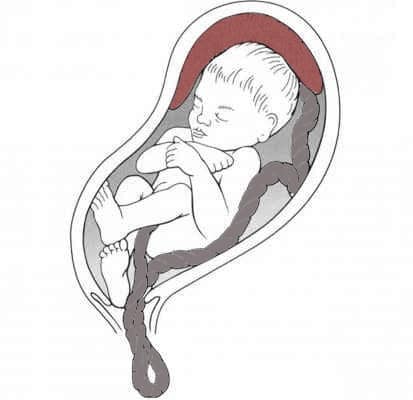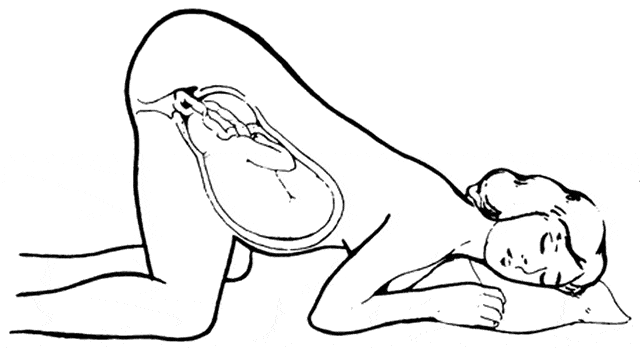what to do if cord prolapse at home
Umbilical cord prolapse is where the umbilical cord descends through the cervix, with (or before) the presenting part of the fetus. It affects 0.ane - 0.6% of births.
Cord prolapse occurs in the presence of ruptured membranes, and is either occult or overt:
- Occult (incomplete) cord prolapse - the umbilical cord descends alongside the presenting office, just not beyond it.
- Overt (complete) string prolapse - the umbilical cord descends by the presenting role and is lower than the presenting part in the pelvis.
- Cord presentation - the presence of the umbilical cord betwixt the presenting part and the cervix. This can occur with or without intact membranes.
Although the incidence is relatively low, the mortality charge per unit for such babies is high (~91 per thou). This is largely because cord prolapse occurs more frequently in preterm babies, who are often breech, and who may also have othercongenital defects.
In this article, nosotros shall wait at the risk factors, clinical features and management of string prolapse.
Pathophysiology
Umbilical string prolapse is where the umbilical string descends through the cervix, with (or before) the presenting office of the fetus. Subsequently, f etal hypoxia occurs via two main mechanisms:
- Apoplexy - the presenting role of the fetus presses onto the umbilical cord, occluding blood flow to the fetus.
- Arterial vasospasm - the exposure of the umbilical cord to the common cold atmosphere results in umbilical arterial vasospasm, reducing blood flow to the fetus.
Risk Factors
The main risk factors for cord prolapse include:
- Breech presentation - in a fiddling breech, the cord can hands slip between and past the fetal feet and into the pelvis.
- Unstable lie - this is where the presentation of the fetus changes betwixt transverse/oblique/breech and dorsum.
- If >37 weeks gestation, consider inpatient access until commitment due to risk of cord prolapse
- Artificial rupture of membranes - peculiarly when the presenting role of the fetus is high in the pelvis.
- Polyhydramnios - excessive amniotic fluid around the fetus
- Prematurity
[explanation id="attachment_14008" align="aligncenter" width="312"] Fig ane - A footling breech and umbilical cord prolapse.[/caption]
Fig ane - A footling breech and umbilical cord prolapse.[/caption]
Clinical Features and Differential Diagnosis
Cord prolapse should always be considered in the presence of a non-reassuring fetal center charge per unit design and absent membranes. It can be confirmed past external inspection or on digital vaginal exam. This is one of the reasons that vaginal assessment, later abdominal test, encompasses a full assessment in the presence of a non-reassuring fetal heart rate blueprint.
The fetal heart rate patterns can vary from subtle changes, such as decelerations with some of the contractions, to more obvious signs of fetal distress, such as a fetal bradycardia. The latter is strongly associated with cord prolapse; relating to the mechanism of occlusion of the cord by the presenting function.
An alternative diagnosis may be considered in the presence of haemorrhage per vagina or heavily claret-stained liquor with ruptured membranes. This would advise placental abruption (the placenta starts to separate from the uterine wall) or vasa praevia (fetal vessels running in the fetal membranes adjacent to the internal os of the cervix).
Management
Firstly, call for assist - umbilical cord prolapse is an obstetric emergency. It should be managed as follows:
- Avoid handling the cordto reduce vasospasm.
- Manually elevate the presenting part by lifting the presenting role off the cord by vaginal digital examination. Alternatively, if in the community, fill the maternal float with 500ml of normal saline (warmed if possible) via a urinary catheter and arrange immediate hospital transfer.
- Encourage into left lateral position with head downwards and pillow placed under left hip OR knee-chest position. This will salvage pressure off the string from the presenting part.
- Consider tocolysis (e.g. terbutaline) - if commitment is not imminently available this volition relax the uterus and stop contractions, relieving pressure off the cord. It may exist sufficient to let enough time for transfer to a location where delivery is feasible (e.g. an operating theatre for a Caesarean section). This is a particularly useful strategy if in that location are fetal centre rate abnormalities while preparing for a C-section.
- Delivery is unremarkably via emergency Caesarean section
- If fully dilated and vaginal commitment appears imminent, encourage pushing or consider instrumental delivery.
- If at threshold for viability (23 + 0 weeks - 24 + half dozen weeks) and extreme prematurity, expectant direction may exist discussed due to significant maternal morbidity with caesarean at this gestation and poor fetal outcomes.
[caption id="attachment_14003" marshal="aligncenter" width="531"] Fig 2 - The knee-breast position, used in the management of cord prolapse.[/caption]
Fig 2 - The knee-breast position, used in the management of cord prolapse.[/caption]
[start-clinical]
Summary
- Umbilical cord prolapse occurs when the cord descends through the cervix and is alongside or below the presenting part of the fetus.
- It is an obstetric emergency, with a fetal mortality rate of 91 per 1000.
- The diagnosis should be suspected in whatsoever patient with a non-reassuring fetal center trace and absent membranes.
- The start step is to call for help when the diagnosis is made.
- Manage by manually elevating the presenting function, and deliver via the quickest style (normally Caesarean section).
[end-clinical]
Source: https://teachmeobgyn.com/labour/emergencies/cord-prolapse/
0 Response to "what to do if cord prolapse at home"
Postar um comentário